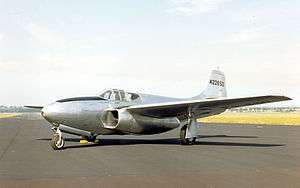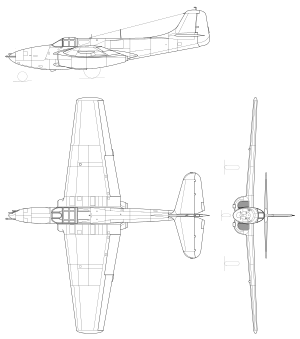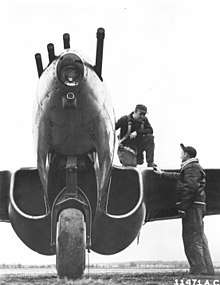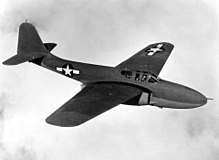Bell P-59 Airacomet
The Bell P-59 Airacomet was a twin jet-engined fighter aircraft, the first produced in the United States, designed and built by Bell Aircraft during World War II. The United States Army Air Forces were not impressed by its performance and cancelled the contract when fewer than half of the aircraft ordered had been produced. Although no P-59s entered combat, the fighter paved the way for another design generation of U.S. turbojet-powered aircraft, and was the first turbojet fighter to have its turbojet engine and air inlet nacelles integrated within the main fuselage.
| P-59 Airacomet | |
|---|---|
 | |
| Bell P-59B Airacomet at the National Museum of the United States Air Force, Dayton, Ohio | |
| Role | Fighter |
| National origin | United States |
| Manufacturer | Bell Aircraft |
| First flight | 1 October 1942 |
| Primary users | United States Army Air Forces United States Navy Royal Air Force |
| Number built | 66 |
Design and development
Major General Henry H. "Hap" Arnold became aware of the UK's jet program when he attended a demonstration of the Gloster E.28/39 in April 1941. The subject had been mentioned, but not in depth, as part of the Tizard Mission the previous year. He requested, and was given, the plans for the aircraft's powerplant, the Power Jets W.1, which he took back to the U.S. He also arranged for an example of the engine, the Whittle W.1X turbojet, to be flown to the U.S in October 1941 in the bomb bay of a USAAC Consolidated B-24 Liberator,[1] along with drawings for the more powerful W.2B/23 engine and a small team of Power Jets engineers.[2] On 4 September, he offered the U.S. company General Electric a contract to produce an American version of the engine, which subsequently became the General Electric I-A. On the following day, he approached Lawrence Dale Bell, head of Bell Aircraft Corporation, to build a fighter to utilize it. Bell agreed and set to work on producing three prototypes. As a disinformation tactic, the USAAF gave the project the designation "P-59A", to suggest it was a development of the unrelated Bell XP-59 fighter project which had been canceled. The design was finalized on 9 January 1942, and construction began. In March, long before the prototypes were completed, an order for 13 "YP-59A" preproduction machines was added to the contract.
On 12 September 1942, the first XP-59A was sent to Muroc Army Air Field (today, Edwards Air Force Base) in California by train for testing, taking seven days to reach Muroc.[3] While being handled on the ground, the aircraft was fitted with a dummy propeller to disguise its true nature.[4] The aircraft first became airborne during high-speed taxiing tests on 1 October with Bell test pilot Robert Stanley at the controls, although the first official flight was made by Col Laurence Craigie the next day.[3] A handful of the first Airacomets had open-air flight observer stations (similar to those of biplanes) later cut into the nose; over the following months, tests on the three XP-59As revealed a multitude of problems including poor engine response and reliability (common shortcomings of all early turbojets), insufficient lateral stability, i.e., in the roll axis,[5] and performance that was far below expectations. Chuck Yeager flew the aircraft and was dissatisfied with its speed, but was amazed at its smooth flying characteristics. Nevertheless, even before delivery of the YP-59As in June 1943, the USAAF ordered 80 production machines, designated "P-59A Airacomet".
Operational service

The 13 service test YP-59As had a more powerful engine than their predecessor, the General Electric J31, but the improvement in performance was negligible, with top speed increased by only 5 mph and a reduction in the time they could be used before an overhaul was needed. One of these aircraft, the third YP-59A (S/n: 42-22611) was supplied to the Royal Air Force (receiving British serial RG362/G), in exchange for the first production Gloster Meteor I, EE210/G.[6] British pilots found that the aircraft compared very unfavorably with the jets that they were already flying. (The YP-59A also compared unfavorably with the propeller-driven North American P-51 Mustang.) Two YP-59A Airacomets (42-108778 and 42-100779) were also delivered to the U.S. Navy where they were evaluated as the "YF2L-1" but were quickly found completely unsuitable for carrier operations.
Faced with their own ongoing difficulties, Bell eventually completed 50 production Airacomets, 20 P-59As and 30 P-59Bs; deliveries of P-59As took place in the fall of 1944.[7] Each was armed with one 37 mm M4 cannon and 44 rounds of ammunition and three .50 cal (12.7 mm) machine guns with 200 rounds per gun. The P-59Bs were assigned to the 412th Fighter Group to familiarize AAF pilots with the handling and performance characteristics of jet aircraft.[8] By 1950, all examples of the Airacomet were no longer airworthy. Over time, disposal of the aircraft included use as static displays, instructional aids in military training, and as static targets. While the P-59 was not a great success, the type did give the USAAF experience with the operation of jet aircraft, in preparation for the more advanced types that would shortly become available.[9]
Variants

- XP-59
- Unrelated piston engine-powered pusher propeller design developed from the Bell XP-52. Not built.
- XP-59A
- Prototype of the jet engine-powered version, three built, serial numbers 42-108784/108786.
- YP-59A
- Series of test aircraft, 13 built, serial numbers 42-108771/108783.
- YP-59A recon prototype
- YP-59A with armament replaced by an observer seat.
- YF2L-1
- Two YP-59A (42-108778/108779) delivered to the US Navy for carrier evaluation as Bu63960/63961.
- P-59A
- First production version, 20 built, serial numbers 44-22609/22628. Redesignated ZF-59A in June 1948.
- XP-59B
- Study for P-59A fitted with Halford H-1/Goblin engines.[10]
- P-59B
- Improved P-59A. 80 aircraft ordered but only 30 built, serial numbers 44-22629/22658, further 50 (44-22659/22708) canceled. Redesignated ZF-59B in June 1948.
Operators
- Royal Air Force received one aircraft, becoming RG362/G, in exchange for a Gloster Meteor I EE210/G.
- United States Army Air Forces
- 412th Fighter Group
- 445th Fighter Squadron
- 412th Fighter Group
- United States Navy
Surviving aircraft

Six P-59s are known to survive today.
- On display
- XP-59A
- 42-108784 – National Air and Space Museum in Washington, DC.[11]
- P-59A
- 44-22614 – March Field Air Museum, March Air Reserve Base (former March AFB) in Riverside, California.[12]
- P-59B
- 44-22633 – Edwards AFB.[13]
- 44-22656 – Pioneer Village (Nebraska) in Minden, Nebraska.[14]
- 44-22650 – National Museum of the United States Air Force at Wright-Patterson Air Force Base near Dayton, Ohio.[15]
- Under restoration
- YP-59A
- 42-108777 – being restored to flying condition with General Electric J31 engines by Planes of Fame Museum in Chino, California.[16]
Specifications (P-59B)

Data from The American Fighter[17]
General characteristics
- Crew: 1
- Length: 38 ft 10 in (11.84 m)
- Wingspan: 45 ft 6 in (13.87 m)
- Height: 12 ft 4 in (3.76 m)
- Wing area: 386 sq ft (35.9 m2)
- Airfoil: root: NACA 66-014; tip: NACA 66-212[18]
- Empty weight: 8,165 lb (3,704 kg)
- Gross weight: 11,040 lb (5,008 kg)
- Max takeoff weight: 13,700 lb (6,214 kg)
- Powerplant: 2 × General Electric J31-GE-5 centrifugal-flow turbojet engines, 2,000 lbf (8.9 kN) thrust each
Performance
- Maximum speed: 413 mph (665 km/h, 359 kn) at 30,000 ft (9,144 m)
- Cruise speed: 375 mph (604 km/h, 326 kn)
- Range: 375 mi (604 km, 326 nmi)
- Service ceiling: 46,200 ft (14,100 m)
- Time to altitude: 30,000 ft (9,144 m) in 15 minutes 30 seconds
Armament
- Guns:
- 1x 37 mm M10 autocannon with 44 rounds of ammunition
- 3x .50 cal (12.7 mm) AN/M2 Browning heavy machine guns with 200 rounds per gun
- Rockets: 8× 60 lb (30 kg) rockets
- Bombs: 2,000 lb (910 kg) bombs
See also

Aircraft of comparable role, configuration and era
- de Havilland Vampire
- Gloster E.1/44
- Gloster Meteor
- Lockheed P-80 Shooting Star
- Messerschmitt Me 262
- Nakajima Kikka
- Sukhoi Su-9
Related lists
References
Notes
- Meher-Homji, Cyrus B. (2000). The historical evolution of turbomachinery (PDF). Proceedings of the 29th turbomachiery symposium. pp. 281–322.
- "power jets – electric company – meteor – 1945 – 2022 – Flight Archive".
- Air International March 1980, p. 133.
- Donald 1995, p. 13.
- Green 1961, p. 19.
- "Gloster Meteor." Flight, 27 May 1955, p. 727.
- "P-59A Airacomet". March Field Air Museum. Retrieved 19 November 2017.
- "Bell XP-59A Airacomet." Archived 4 January 2012 at the Wayback Machine Smithsonian National Air and Space Museum. Retrieved: 15 December 2011.
- Baugher 2006
- http://imagery.vnfawing.com/PDF-Archive/Lockheed-Skunk-Works.pdf%5B%5D
- "XP-59A Airacomet/42-108784" Archived 4 January 2012 at the Wayback Machine National Air and Space Museum Retrieved: 14 December 2010.
- "P-59A Airacomet/44-22614" Archived 23 December 2005 at the Wayback Machine March Field Air Museum Retrieved: 10 April 2012.
- "P-59B Airacomet/44-22633" John Weeks Retrieved: 14 December 2010.
- "P-59B Airacomet/44-22656" John Weeks Retrieved: 14 December 2010.
- "P-59B Airacomet/44-22650" Archived 26 August 2007 at the Wayback Machine National Museum of the United States Air Force Retrieved: 10 April 2012.
- "YP-59A Airacomet/42-108777" Planes of Fame Museum Retrieved: 10 April 2012.
- Angelucci and Bowers 1987, p. 50.
- Lednicer, David. "The Incomplete Guide to Airfoil Usage". m-selig.ae.illinois.edu. Retrieved 16 April 2019.
Bibliography
- "Airacomet... a jet pioneer by Bell". Air International, Vol. 18 No. 3, March 1980, pp. 132, 139. Bromley, UK: Fine Scroll. ISSN 0306-5634.
- Andrade, John M. U.S. Military Aircraft Designations and Serials since 1909. Earl Shilton, Leicester, UK; Midland Counties Publications, 1979. ISBN 0-904597-21-0.
- Angelucci, Enzo and Peter Bowers. The American Fighter. Yeovil, UK: Haynes, 1987. ISBN 0-85429-635-2.
- Baugher, Joe. "Bell P-59 Airacomet". USAAC/USAAF/USAF Fighter and Pursuit Aircraft: Original Fighter Series-1922 to 1962, 27 June 2002. Retrieved: 15 December 2010.
- Carpenter, David M. Flame Powered: The Bell XP-59A Airacomet and the General Electric I-A Engine. Boston: Jet Pioneers of America, 1992. ISBN 0-9633387-0-6.
- Donald, David, ed. American Warplanes of World War II. London: Aerospace Publishing, 1995. ISBN 1-874023-72-7.
- Green, William. War Planes of the Second World War, Volume Four: Fighters. London: MacDonald & Co. (Publishers) Ltd., Sixth edition 1969, First edition 1961. ISBN 0-356-01448-7.
- Green, William and Gordon Swanborough. WW2 Aircraft Fact Files: US Army Air Force Fighters, Part 2. London: Macdonald and Jane's Publishers Ltd., 1978. ISBN 0-354-01072-7.
- Jenkins, Dennis R. and Tony R. Landis. Experimental & Prototype U.S. Air Force Jet Fighters. North Branch, Minnesota, USA: Specialty Press, 2008. ISBN 978-1-58007-111-6.
- Pace, Steve. "Bell P-59 Airacomet." AIR FORCE LEGENDS NUMBER 208. Ginter Books, Simi Valley, California. ISBN 0-942612-93-0. 2000.
- Pelletier, Alan J. (1992). Bell Aircraft Since 1935. Annapolis, Maryland: Naval Institute Press. pp. 50–54. ISBN 978-1-55750-056-4.
- United States Air Force Museum booklet. Dayton, Ohio: Air Force Museum Foundation, Wright-Patterson AFB, Ohio, 1975.
External links
| Wikimedia Commons has media related to Bell P-59 Airacomet. |